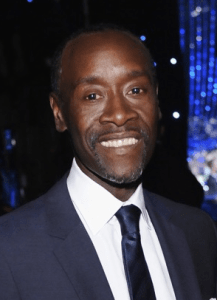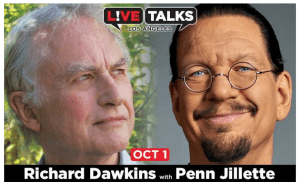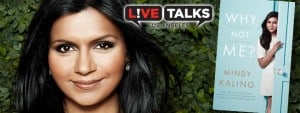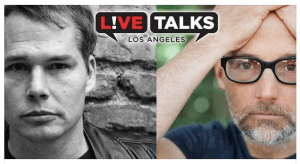Blog
Parking for Marie Kondo event at Barnum Hall, Santa Monica High School
We expect a big audience for our event with Marie Kondo and Jamie Lee Curtis, so plan on arriving early.
Doors to the theatre open at 7:15pm and we start at 8pm.
Parking is available in these two spaces. According to the City of Santa Monica website is $5 to park:
— Civic Center Parking Lot at the corner of 4th Street and Pico Blvd.
Access to the parking lot is via Main Street or 4th Street
— Civic Center Parking Garage, at corner of 4th Street and Civic Center Way
— There is limited parking for those with handicapped parking permits in the Olympic parking lot and Barnum parking lot.
There is a Walkway off of 4th street, next to the Double Tree Hotel that has direct access to the Santa Monica High School campus. Look for direction signs and attendants providing directions.
Q&A with Don Cheadle on the making of “Miles Ahead”
 We host Don Cheadle at Live Talks Los Angeles on March 30 discussing the movie, Miles Ahead, which he directed, starred in and co-wrote the screenplay.
We host Don Cheadle at Live Talks Los Angeles on March 30 discussing the movie, Miles Ahead, which he directed, starred in and co-wrote the screenplay.
WHO WAS MILES DAVIS AND WHY DID YOU FEEL COMPELLED TO MAKE A MOVIE ABOUT HIM?
I’ve been steeped in Miles Davis’ music since the age of ten. He is so many things, not the least of which is an indefatigable symbol of creative energy and power; someone who was never afraid to step out of his comfort zone; someone who was totally uncomfortable with stasis.
Over the years I was approached by various people, some of whom were close to Miles and others who just wanted to see a movie about him; and they said that if anyone should play him it was me. I’d already been in a number of standard bio-pics and I had no interest in making another since I found them full of contrivances and fabrications. You know, “based on a true story.”
Shortly after Miles was inducted into the Rock and Roll Hall of Fame I was approached by his family. They pitched me several different takes but I didn’t spark to any of them. To me, they didn’t go far enough in trying to capture his enormous creativity and dynamism. So we shook hands and promised to keep in touch. As I pondered it further, I began to imagine a film that would capture Miles as who he was, a man full of drive and forward momentum but also mercurial and dangerous, the real O.G. original gangsta. And I realized that it would never happen unless I wrote it. So I asked the family if they were okay with that and they said “Cool. Do it.”
THERE ARE AT LEAST FIVE FEATURE LENGTH MOVIES THAT COULD BE MADE ABOUT MILES DAVIS’ INCREDIBLE LIFE. WHY DO YOU THINK IT TOOK SO LONG TO MAKE JUST ONE?
A big reason is that jazz has been swept into a corner and no longer seems to have relevance to a modern audience. Miles still has great name recognition and “Kind of Blue” still sells more than 50,000 albums a year. But while most people I asked recognized that he was a jazz musician, they didn’t know he played the trumpet and many confused him with Dizzy Gillespie. ‘Oh yeah, you mean the guy who blew out his cheeks.’
Miles’ music is not immediately identifiable like some oldie rock hit. You can’t sing it. It isn’t over in three minutes. Unless people hear it on the radio, they have no connection to it. Another reason is that music appreciation is no longer taught in public schools. So when a studio looks at a movie like that all they see is: period piece, black, jazz, niche, hard sell, no foreign appeal.
RATHER THAN A CONVENTIONAL BIO-PIC, YOU CHOSE A PIVOTAL POINT IN HIS LIFE TO ILLUMINATE HIS PAST AND HINT AT HIS FUTURE. TELL US ABOUT THAT DECISION.
It was a stop and start process, setting up deals, working with writers, and having deals fall apart after the financial collapse of the economy. I tried to give the project away to other directors, figuring that an established name could help move the project forward. But we always seemed to end up back at square one.
Then I met the writer Steven Baigelman. We both agreed that we didn’t want a cradle to grave biography, which would involve too much shorthand and you’d come away feeling cheated. The movie I envisioned featured Miles as the star of his own movie like Bob Fosse in All that Jazz. I also wanted a film in which the story was always moving forwards, that had raw energy.
Because that’s who Miles was. He never looked back, always forward. He was innovative and prolific and his style was always changing. And yet, for a five year period in the late ‘70s, he was stymied, blocked and frustrated. That crisis period seemed to be a great entry point. You don’t have to know anything about jazz to understand the dilemma. A prolific artist stopped creating for five years. What was that all about?
Like Miles’ music, the structure Steve and I decided on for the narrative is modal. It’s as much a composition as any of Miles’ recordings. It’s loose and impressionistic. It is also metaphoric. The sections of the film that focus on his relationship with Frances Davis (Emayatzy Corinealdi) are a comment on the main story that takes place in 1979 when Miles is plagued by a writer’s block and deteriorating hip and using drugs to numb the pain. Frances represents his muse, the voice he has lost and is trying to recapture. The audio tape he loses in the “present” scenes also represent the loss of a relationship, the relationship to his music. Even the character of Junior (Keith Stanfield), the talented young trumpet player he meets, echoes his complex relationship to the past. As a young musician, Miles was called “junior” by Charlie Parker and Dizzy Gillespie, a nickname he hated, by the way.
THE FILM SEEMS TO OPERATE ON TWO SPEEDS. THE PRESENT SCENES ARE FAST AND DANGEROUS, WHILE HIS PAST IS COOLER, MORE CONTROLLED AND OFTEN ROMANTIC. WAS THAT A CONSCIOUS DECISION?
Absolutely. They counterpoint one another. But gradually, the two periods move together. His recollections of Frances, like his music, are cool and controlled, romantic and seductive, as opposed to his self-destructive present, which is completely out of control. But as we move forward in his relationship to Frances, the romantic scenes get more jangly and chaotic because Miles can no longer control the narrative. As he reflects on that period, he is finally forced to admit that his abusive behavior led to the destruction of that relationship and contributed to his current creative roadblock. He can no longer lie to himself. In letting go of that lie, he regains his music. But at the same time he loses his muse. In the end, he realizes that he can’t have both.
HOW DID MILES’ EVOLVING STYLES OF JAZZ INFLUENCE THE DIRECTING?
A big motivator for me was to create a methodology that would allow me to use music from all periods of Miles’ career; that would enable me to externalize his interior conflict. We used music from every era and every style of Miles’ life and we wrote and shot the scenes to that music. We didn’t hamstring ourselves by only using pieces from one particular era because throughout his life, Miles wrote soundtrack. His music reflected the era in which he wrote it, but was often ahead of the period. He hated the term jazz. He preferred “social music.”
We let the storytelling dictate what piece of music we’d use. Sometimes it was part of the period, like when we used “Nefertitti’ behind the scene where Miles and Frances quarrel. The record is playing in the scene and we just let it play throughout and it made the sequence so much more painful and poignant than hearing the specifics of the argument.
In the boxing scene, set in the ‘present,’ we use “So What” (originally from the album “Kind of Blue”) from his Tokyo and Bootleg sessions (both from the 1960s), because it was the perfect piece for that sequence. The structure of the movie allowed us to use different styles, including rock and funk and electric, rather than doing a sequential “greatest hits” soundtrack.
DAVIS WAS MARRIED SEVERAL TIMES, BUT YOU CHOSE TO EXPLORE HIS YEARS WITH THE DANCER FRANCES TAYLOR. WHY?
Frances was with Miles in what I call the “So What” era, his traditional emblematic jazz music and both the relationship and that style of music came to an end when the marriage fell apart. He had taken that music as far as he could push it and after that he didn’t play it anymore.
Also, Frances was significant in his life, a period of romance and connection. Then he tries to lock her down and she walks out. Having her and losing her became a symbol for his loss of musical expression. No more music for Miles was death. And only when he finally acknowledges what he’s done, is he able to break through that block and take off again and grow and move forward.
AS WITH MANY GREAT ARTISTS, THE FILM SEEMS TO SUGGEST THAT MILES’ GENIUS SOMETIMES BORDERED ON A KIND OF MADNESS.
Absolutely. He couldn’t shut it off. Music was constantly in his head. The one place I show that is the scene in which he and Frances make love and afterwards he is watching her dance. And then suddenly he’s gone. She finds him downstairs playing the inspiration he just got from her into the trumpet. He was always composing in his head.
Miles was a restless soul. He always had to be doing something. If it wasn’t music, he would box or he’d do blow or he’d cook. He could not sit in it, couldn’t stop moving, couldn’t stop doing. He’d change his clothes or paint or tinker on the piano. He was constantly agitated. When he played music, it gave him an outlet. When he stopped, the energy fed on itself, sometimes destructively so.
Miles was completely mercurial. I think today he’d be analyzed as bi-polar. One minute he’d get angry and punch you out, and the next he’d pour you a drink and sit down beside you to chat as if nothing had happened.
TELL US A BIT ABOUT THE DEVELOPMENT OF THE SCRIPT.
The main problem as with all biographical films was what to include and what to leave out. At first we asked ourselves, should we talk about Coltrane, do should we talk about Quincy Jones? I mean, how do you show musical genius?
Ultimately, we decided to focus on depicting an artist going fallow. Again I took my cue from Miles’ music. Instead of a reverential bio, I wanted to push it every way I could, go out on a limb and take a risk. Like bringing in the character of Junior, who is actually Miles. And Junior’s wife is Miles’ first wife, Irene. Through that character Miles gets to see the young Miles. But we don’t underline it. Only if you know Miles’ life do you understand that it’s him.
THOUGH THE MUSICAL PERFORMANCES ARE MILES DAVIS’ YOU PLAY THE TRUMPET LIKE A PRO. DID IT TAKE LONG TO DEVELOP THE PROPER BREATH AND MANUAL CONTROL OF THE INSTRUMENT?
As a kid, back in fifth grade, I played the alto sax and I would listen to people like Charlie Parker and try to figure out how they were playing. It was much easier then to slow down a 78 record on a hi-fi to 33. Once I committed to learning the trumpet for the film, I played every day and still do. I’ve become completely geeky about it. I’d say I’ve gotten to the level of a good ninth-grade trumpet player.
The trumpet is a completely different instrument but it makes more sense to me than the sax. I understand the octaves and arpeggios better, but maybe that’s the benefit of being 48 and not 18.
I watched film and video of Miles and I also had seen him perform in the early 80s shortly after the period in the film. Wynton Marsalis who is a good friend also helped. He said ‘I know every great Miles solo. So anything you need just ask.’ Wynton was a great help. He even sent me my first trumpet.
I learned all the solos for the performance scenes in the movie and the band behind me learned how to play ‘Miles Ahead.’ I felt we needed to learn how to play it in order to understand it. That’s me playing and the band too, only you’re not hearing our sound.
YOU DISAPPEAR SO COMPLETELY INTO THE CHARACTER OF MILES THAT IT MAKES ONE WONDER WHETHER YOU DIRECTED THE MOVIE AS HIM, RASP AND ALL.
I did and I stayed in it for as long as I could, but sometimes I would have to come out of character in order to be heard. People used to call Miles ‘chief,’ because he was always running the show. In directing, I connected myself to that part of Miles. I figured if I was going to depict who he was, I would have to do it the way Miles would have done it. Like learning the trumpet, I took it as far as I could. If I thought a scene was too conventional and I wasn’t scared, I knew I had to go here. Herbie Hancock and Wayne Shorter (who appear in the ‘concert’ at the end of the film) said it was the only way to tell Miles’ story. His family did as well.
THE CONCERT SEQUENCE THAT ENDS THE FILM IS NOT AN ACTUAL MILES DAVIS CONCERT BUT WHAT YOU CALL A ‘META CONCERT.’ EXPLAIN YOUR DECISION TO END THE FILM THAT WAY.
The group we put together included older musicians Miles had played with like Herbie and Wayne as well as newer jazz performers like Esperanza Spaulding and Gary Clark Jr. It’s exactly the kind of group Miles might put together, a collage, very free form, almost like watching a rehearsal that’s open to the public.
With the family’s permission, I used Miles’ paintings as a backdrop. But like the music, we manipulated them, almost like visual sampling. Again, it’s what Miles would have done. Before rap he was already doing sampling in his music, the only difference is that it was analog instead of digital.
Do you have a question for Marie Kondo?
 Do you have a great question for Marie Kondo? Here’s your chance to win a signed copy of her new book. We will pick 10 questions, and if yours is selected, we ship you a signed copy of Spark Joy to anywhere in the US.
Do you have a great question for Marie Kondo? Here’s your chance to win a signed copy of her new book. We will pick 10 questions, and if yours is selected, we ship you a signed copy of Spark Joy to anywhere in the US.On Monday, January 25, we host Marie Kondo in conversation with Lisa Napoli at Live Talks Los Angeles at a sold out event at the Aero Theatre in Santa Monica, CA. Here’s your chance to win a signed copy of Marie Kondo’s new book, Spark Joy: An Illustrated Master Class on the Art of Organizing and Tidying Up, the follow up to the runaway bestseller, The Life Changing Magic of Tidying Up.
Questions must be received by n0on on Monday, January 25.
Please email your question to info@livetalksla.org with “Kondo Question” in the subject line. If we pick your question, we will email you and ask for your address.
Do you have a question for Shepard Fairey?
Tomorrow, October 6, we host Shepard Fairey in conversation with Moby at a sold out event at the Ann and Jerry Moss Theatre at New Roads School. Here’s your chance to win a signed copy of Shepard Fairey’s new book, COVERT TO OVERT:The Under/Overground Art of Shepard Fairey.
If you have a great question for Shepard Fairey, here’s your chance to win a signed copy of his book. We will pick 10 questions, and if yours is selected, we ship you a signed copy of Shepard Fairey’s book.
Questions must be received by noon, on Oct 6.
Please email your question to info@livetalksla.org with “Shepard Question” in the subject line. If we pick your question, we will email you and ask for your address.
Do you have a question for Richard Dawkins? Your chance to win a signed book.
 Tomorrow, October 1, we host Richard Dawkins at a sold out event at the Moss Theatre in Santa Monica. He’ll be interviewed by Penn Jillette. Here’s your chance to win a signed copy of Dawkins’ book, Brief Candle in the Dark: My Life in Science.
Tomorrow, October 1, we host Richard Dawkins at a sold out event at the Moss Theatre in Santa Monica. He’ll be interviewed by Penn Jillette. Here’s your chance to win a signed copy of Dawkins’ book, Brief Candle in the Dark: My Life in Science.
If you have a great question for Richard Dawkins, here’s your chance to win a signed copy of his book. We will pick 10 questions, and if yours is selected, we ship you a signed copy of Richard Dawkins’ book.
Please email your question to info@livetalksla.org with “Dawkins Question” in the subject line. If we pick your question, we will email you and ask for your address.
Questions must be submitted by 12pm on October 1.
Richard Dawkins in the news…
— Wall Street Journal, Sept 29 — A Biologists Worldview
— Wall Street Journal, Sept 29 — video interview with WSJ’s Gautam Naik
Do you have a question for Mindy Kaling? Your chance to win a signed book!
 This Sunday, September 27, we host Mindy Kaling at a sold out event at the Alex Theatre. Here’s your chance to win a signed copy of Mindy Kaling’s collection of essays, Why Not Me?
This Sunday, September 27, we host Mindy Kaling at a sold out event at the Alex Theatre. Here’s your chance to win a signed copy of Mindy Kaling’s collection of essays, Why Not Me?
If you have a great question for Mindy, here’s your chance to win a signed copy of her book. We will pick 10 questions, and if yours is selected, we ship you a signed copy of Mindy Kaling’s book.
Please email your question to info@livetalksla.org with “Mindy Question” in the subject line. If we pick your question, we will email you and ask for your address.

